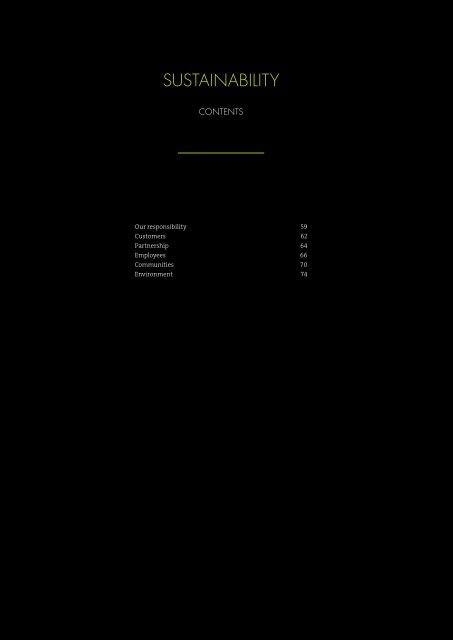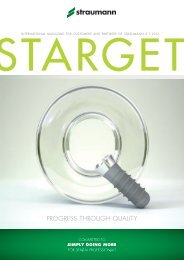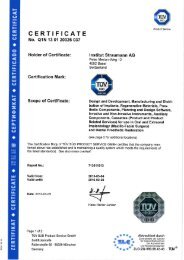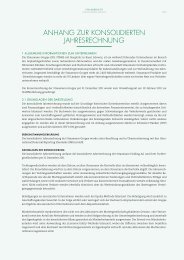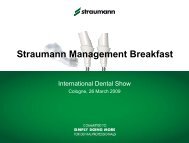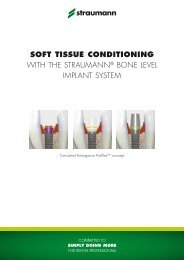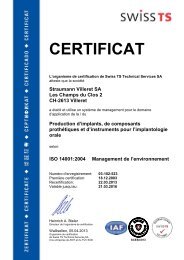SuStainability - 2012 - Straumann
SuStainability - 2012 - Straumann
SuStainability - 2012 - Straumann
- No tags were found...
You also want an ePaper? Increase the reach of your titles
YUMPU automatically turns print PDFs into web optimized ePapers that Google loves.
SustainabilityCONTENTSOur responsibility 59Customers 62Partnership 64Employees 66Communities 70Environment 74
operational reviewSustainability 61’Corporate responsibility and sustainabilityare entrenched in <strong>Straumann</strong>’s managementprOCESSES and procedures.‘Strategic aspects of sustainability management are ultimatelythe responsibility of the Board of Directors. While theBoard has delegated operational aspects to the ExecutiveManagement, it reviews sustainability performance dataannually. The CFO is tasked with the oversight of environmentalperformance and sustainability. In all our businessactivities, we place a high value on ethical behavior and onupholding human rights. For our own operations, this is ensuredby the <strong>Straumann</strong> Code of Conduct, and with regard toexternal partners by our Code of Conduct for Suppliers. BothCodes are discussed on p. 73.Company visits are one of the many opportunities we havefor direct contact with stakeholders. In 2011, more than ahundred groups including over 1200 participants visited ourSwiss sites alone. These visitors included customers, educators,scientists, investors, analysts, politicians, representativesof the media, members of the general public, and business/culturaldelegations from various countries.Sustainability is an integral element in <strong>Straumann</strong>’s corporatecommunications to investors, customers, and otherstakeholders. This is illustrated by the fact that the sustainabilityreporting guidelines of the Global Reporting Initiative(GRI) were followed in preparing this annual report (seep. 238).Having established new Leadership Principles in 2010, wedeveloped specific leadership competencies for each Principle.We also included the Principles in a 360° Leadership assessment,which was piloted in half our Senior Managementteam. More than 100 internal respondents provided feedbackon the Leaders – for example with regard to the Principles of‘integrity’, ‘compelling communication’, and ‘leveraging diversityto achieve the best team results’. All of these were ratedhighly. By contrast, ‘coaching/developing’ was seen as anarea for improvement and shall be included in an advancedleadership development program. The 360° assessment pilotwill be extended to other managers.FTSE Group confirms that <strong>Straumann</strong> Holding AG has been independentlyassessed according to the FTSE4Good criteria, and has satisfied the requirementsto become a constituent of the FTSE4Good Index Series. Created bythe global index company FTSE Group, FTSE4Good is an equity index seriesthat is designed to facilitate investment in companies that meet globallyrecognized corporate responsibility standards. Companies in the FTSE4GoodIndex Series have met stringent social, ethical and environmental criteria, andare positioned to capitalize on the benefits of responsible business practice.DIALOGUE WITH ALL OUR STAKEHOLDERSOpen and continuous dialogue with our stakeholders, particularlythose who determine our performance and thoseon whom we have a major impact, is an important part ofresponsible corporate behavior at <strong>Straumann</strong>. The processesand results of this dialogue are discussed throughoutthis report, including those concerning staff, customers, environmentallyinterested stakeholders, communities, andinvestors.References/footnotes1 United Nations, Department of Economic and Social Affairs, PopulationDivision, World Population Ageing 1950–2050: Chapter II Magnitudeand Speed of Population Ageing, 2001, and Population ReferenceBureau, 2011 World Population Data Sheet, 2011.
62operational reviewSustainabilityCUSTOMERSDIVERSE CUSTOMERS REquirE individual SERVICESAND tailORED COmmuniCATIONstraumann’s customers by segmentstraumann’s customers by REGIOnDental technicians/laboratories18%Asia/Pacific& Rest of World14%General dentists66%Europe52%Specialists16%North America34%<strong>Straumann</strong>’s global customer base comprises general dentists,specialists (e.g. oral surgeons, periodontists, prosthodontists,etc.) and dental technicians/laboratories (see chartabove). <strong>Straumann</strong> serves this diverse group of customersdirectly through our team of more than a thousand sales andmarketing professionals worldwide, most of whom are highlytrained representatives or customer service professionals.FOCUSING AND REORGANIZINGOUR CUSTOMER APPROACHThe expansion of our portfolio, customer base and geographicreach have added complexity, particularly for oursales team. To address this, we started an extensive reorganizationproject in the second half of 2011, including the allocationof our global sales team into four sales forces, eachfocused on specific segments. This should bring us closer tocustomers, facilitate the selling process and thus add toour top-line growth. At the same time, our global productsteam will be organized into business units, which will helpus to respond better to customer needs and shorten time tomarket.FOSTERING COMMUNICATION WITHAND BETWEEN CUSTOMERSTreatment outcomes depend on planning and clear, seamlesscommunication between the dentist, the specialist, thelab and the patient (who is not our ‘ultimate’ customer); seeBusiness Model Chart on p. 13). To support this, in 2011 ourefforts included:• Software updates to our digital communication solutions.• Continued distribution of our award-winning 1demonstration model, which helps dentists explainimplant solutions to their patients and has now beendistributed to 24 000 customers.• Our customer magazine ‘Starget’ achieved a globalcirculation of more than 70 000 and is now accessible viamobile devices.• Continued communication with our customers throughregular e-letters and the complete redesign of our website,which will go live in February <strong>2012</strong>.• Extended educational offerings (see p. 45), anothercritical component of our communication strategy withcustomers.REGULAR DIALOGUE WITH CUSTOMERSWe use a direct sales model which, along with our newlyexpanded Customer Relationship Management (CRM) system,lets us provide individualized, segmented service toour customers and adds significant value in areas such aspractice building, further education and product training.Our customer loyalty program offers enhanced servicesto eligible customers, including consultation on business
operational reviewSustainability 63’using a direct sales model enables usto build relationships with individual customersand to add significant value.‘Weights of PERCEPtion AttRIBUtes (13 countRIES)PricePortfolio& innovationEducationProduct &performanceService &practice supportSource: <strong>Straumann</strong> internal Perception Pulse Study with MillenniumResearch Group, 2011. Country reports from Canada, China, France,Germany, Italy, Japan, Netherlands, Spain, South Korea, Sweden,Switzerland, UK, USA.practices and the opportunity to participate in seminars,congresses, and other special events.One key way that we gather information to help us meetour customers’ expectations is through our participation indental conferences and meetings where opinion leadersgather to share ideas and best practices. In 2011, we showcasedour solutions at more than 20 large trade eventsaround the world, attended by more than half a millionvisitors, including many current and potential customers.Surveys help us understand our customers and our progresstoward meeting their expectations. In 2011, we extendedour survey portfolio with benchmarking studies in Italy,Switzerland, Sweden, Norway, Denmark, the Netherlands,Belgium, the UK, Austria, Spain, and France. This generatedmore than 1000 single point contacts, 3000 referral interviews,and 15 000 patient feedbacks.‘Brand Advocacy Score’, in which <strong>Straumann</strong> was rankedhighest overall by current and former users of our products.In 2011, a ‘Net Promoter Score’ project, which providesrapid, direct feedback, was rolled out to five countries afteran initial pilot project in Germany.OUR COMMITMENT TO PRODUCT QUALITYAND RESPONSIBILITYOur commitment to truthful and accurate marketing materialsand communications is undiminished. Much of thescientific information used to endorse our products is peerreviewed,and we have robust processes and guidelines inplace to check that our marketing materials are ethical andaccurate.In 2011, there were no reported relevant incidents of noncompliancein our Global Sales Compliance program, whichwas developed in 2009 to ensure that regulations regardingthe sale of our products and services are met.OUTLOOKOne of our key priorities in <strong>2012</strong> will be to complete our reorganization,expand our CRM system and support it withstate-of-the-art tools, including tablet-based technology.We will explore various new media and communicationchannels in order to expand and develop customer relationshipswherever possible. We will continue to invest incustomer surveys and focus groups, further enhance andimprove our educational programs, and strengthen ourprofessional networks.We also continued our ‘Perception Pulse’ studies, and includedChina for the first time. One key outcome was theReferences/footnotes1 2011 Health Media Award for Patient Communication.
64operational reviewSustainabilitypartnershipTHE INTErnatiONAL TEAM FOR implantOLOGY (ITI) – A uniquECOllabOratiON BETWEEN ACADEMIA AND induSTRYThe ITI is the largest international, independent academicorganization in the field of implant dentistry. Its primaryfocus is on education – through various channels, includingconferences, courses, and study clubs. It also awardsannual research grants totaling CHF 2.5 million, making itthe largest source of non-governmental funding for researchin the field.The ITI was founded in 1980, when implant dentistry wasstill in its early days. Led by pioneers André Schroeder andFritz <strong>Straumann</strong>, the ITI was instrumental in developingthe field and laying foundations for reliable treatmentsthat have since become routine.From its earliest days, the ITI has worked closely with<strong>Straumann</strong>, and this collaboration has led to many technologicaland therapeutic advances in implant dentistry. TheITI is nonetheless independent, and this independence iscrucial to its credibility with dental professionals. Its activitiesand finances are therefore presented in its own annualreport. The summary below shows how the ITI addsvalue for <strong>Straumann</strong> and its stakeholders.Interaction between straumann and the itistraumanncommercialactivitiesEDUCationnetWORKresearchitiCLINICALactivitiesAccording to the agreement between <strong>Straumann</strong> and the ITI, <strong>Straumann</strong>has sole responsibility for the development of its products but may draw onthe expertise of individuals in the ITI.role: they provide an efficient local platform from whichto disseminate information, and their relatively smallsize fosters informal exchanges in an atmosphere of trust.Some are able to offer continuing education credits, whichare required annually in many countries.RAPID GROWTH LIFTED BY STUDY CLUB SUCCESSAfter growing by more than 10% in the previous two years,the ITI’s membership expanded by 25% in 2011, passingthe 10 000 mark in October. In addition to reflecting theever-increasing acceptance of the organization and itsprinciples, this milestone is all the more remarkable inlight of a significant increase in membership fees in mid-2010.The surge in 2011 is largely due to the launch of a newStudy Club concept in 2010. ITI Study Clubs are an idealchannel for the systematic dissemination of informationto all the organization’s Fellows and Members. The initialgoal was to establish 400 Study Clubs by the end of <strong>2012</strong>,but this was achieved a year early, with more than 450Clubs at the end of 2011. ITI Study Clubs have a uniqueNATIONAL CONGRESSESIn 2011, the ITI organized 14 national congresses whichcollectively drew almost 6000 participants. A further tencongresses are planned for <strong>2012</strong>. With the advantage oflectures in local languages, national congresses are a keyto the transmission of information on implant dentistryaround the world. These are augmented by an extensivecommercial exhibition, which allows participants to explorethe latest equipment and products in the field.Every congress is actively supported and monitored by theEducation Core Group to ensure top quality. All congressesare coordinated by a central Events Management team atthe ITI Center in Basel. This increases efficiency by streamliningadministration and organization, and it allows bestpractices to be shared.
operational reviewSustainability 65’the ITI’s membership expanded by 25% in 2011,passing the 10 000 mark in October.‘The flagship educational event is the ITI World Symposium,which last attracted 4000 participants. It is held everythree to four years and gathers an eminent faculty to debatethe latest, often controversial, issues in the field. Preparatorywork is already underway for the next WorldSymposium in April 2014.ADDITIONAL EDUCATION CHANNELSITI Education Weeks have a long, successful history at theUniversity of Bern and have become very popular, thanksto a balanced program of theory, live surgery and prostheticsessions, some of which are ‘hands-on’. In the past twoyears they have been extended to six other academic institutionsand in 2011, Education Weeks were held in Bern,Boston, Hong Kong, London, Stuttgart and Toronto.Now in its 14th year, the ITI Scholarship program awarded25 one-year scholarships in 2011. The number of ScholarshipCenters has increased steadily and 19 locations around theworld now offer young professionals the opportunity ofspending one year abroad, and gaining experience in implantdentistry under the guidance of an experienced ITIFellow. To date, a total of 184 Scholars from 40 countrieshave benefited from this program with an overall sponsorshipof CHF 9.9 million from the iti.ELECTRONIC TOOLS & RESOURCESThe ITI offers members a portfolio of electronic resourcesto gather and disseminate knowledge as well as tonetwork.The ITInet online platform offers discussion forums at aglobal, national and individual level plus a ‘knowledgepool’ with dynamic up-to-date content. This includes anextensive library of evidence-based reference material forSpeakers and Fellows, including illustrations from the ITI’sTreatment Guide series of publications. Since its inceptionin 2010, the ITInet has gained momentum, with increasinglylively exchanges on its various forums.The highly popular SAC (Straightforward, Advanced, Complex)Assessment Tool, which is available on the internationalITI website free of charge, has now been complementedby an ‘app’ for mobile devices. The unrestrictedavailability of this valuable tool, which offers step-by-steprisk assessment of individual cases, demonstrates the ITI’sdedication to quality assurance in implant dentistry to thebenefit of patients.CHANGING STRUCTURESIn response to the dramatic increase in Study Clubs andtheir priority for the organization, a Study Club Committeewas formed to define their strategic direction and operation.This brings the number of ITI Committees to six: Education,Research, Scholarship, Section & Membership, StudyClub and University Programs.The ITI has made concerted efforts to reflect the heterogeneityof its membership in its Committees. It has loweredthe average age of members and has increased the numberof women on its Committees. With the aim of encouragingthe Sections to contribute to the strategic direction of theorganization, the ITI makes every effort to ensure that eachSection is represented on at least one Committee.OUTLOOKThe ITI continues to work towards establishing itself as theglobal academic authority in implant dentistry. The priorityis to grow while maintaining high quality standards.<strong>Straumann</strong> will continue to be the ITI’s industry partner,nurturing this unique collaboration that brings considerablevalue to customers, patients and investors.
66operational reviewSustainabilityEMPLOYEESFOCUSING ON ChangE, DEVELOPMENT AND PERFOrmanCEIN dialOGUE with EngagED EMPLOYEESemployees (WORLDWIDE)Employees by REGIOn20071955Asia/Pacific8%200820092<strong>2012</strong>170North America19%Switzerland34%2010201123612452Rest of World3%Rest of Europe36%CONTINUED GROWTHOF A LEARNING ORGANIZATIONWhile several leading healthcare companies downsized in2011, we were able to continue to build and shape our team forthe future, although at a lesser rate than in 2010. We added91 new positions – mainly in Marketing & Sales. At the sametime, we initiated a major reorganization project Groupwideto support both our strategy and our Vision 2020 project.The new organization has been designed to increase empowerment,responsibility and entrepreneurism amongour employees. Because a key success factor in reorganizingis to assign people optimally, we are focusing more onevaluation skills, experience and capabilities in our selectionprocess. To support, equip and develop individuals innew roles – and to drive growth – we enhanced our <strong>Straumann</strong>Training Academy and adapted our learning platform,which incorporates training on <strong>Straumann</strong>’s values,ways of working, brand, and products. By providing moreinternal rather than external training, we achieved thesame amount of average training time at lower cost.PROGRAMS FOCUSED ON LEADERSHIP SKILLSHaving established new Leadership Principles in 2010, wedeveloped specific leadership competencies for each Principle.We also included the Principles in a 360° Leadershipassessment, which was piloted in half our Senior Managementteam. More than 100 internal respondents providedfeedback on the Leaders – for example with regard to thePrinciples of ‘integrity’, ‘compelling communication’, and‘leveraging diversity to achieve the best team results’. Allof these were rated highly. By contrast, ‘coaching/developing’was seen as an area for improvement and shall be includedin an advanced leadership development program.The 360° assessment pilot will be extended to other managers.ADVANCING KEY LEADERS<strong>Straumann</strong>’s Strategic Management Development (SMD)process is a structured assessment of key employees. It reviewsperformance, behavior, and career potential as a basisfor development, deployment and succession planning.We also conduct an International Talent Program (ITP),which involves senior line managers as observers. The Programenables us to assess internal talent and support personaland professional development. Over the past fouryears, 50 members of our staff have participated in the ITPand more than 60% of them have since been promoted toroles with greater responsibility.These initiatives helped us to achieve for the first timeour goal of filling 50% of open positions through internal
operational reviewSustainability 67’OUR new organization has been designed to increaseempowerment, responsibility and entrepreneurism.‘employees by functionResearch & Development9%Admin. & Finance20%Marketing& Sales46%FEEDBACK ON PERFORMANCEThe performance of our employees is reviewed against individualobjectives in Performance Review meetings twicea year. More than 95% of our staff participated in suchmeetings in 2011. In addition, individual development goalsare set and reviewed regularly to ensure that our employeescan fulfill their roles effectively and meet the company’srequirements for the future.Production& Logistics24%promotion. The blueprint for our new organization is exemplaryin this respect, as the vast majority of our executiveand senior leadership appointments were internal promotions.DEVELOPING YOUNG TALENTIn 2011, we thoroughly reviewed our Graduate Program,the goal of which is to develop tomorrow’s leaders by attractingwell qualified, high potential university graduatesto the company. Participants are trained in variousparts of the organization in addition to receiving mentoringfrom a member of Senior Management.From <strong>2012</strong> on, a Steering Committee will oversee thisprogram, while a forum will promote networking andcommunity-building among graduates and will exposethem to Executive Management. In <strong>2012</strong>, we expect torecruit a further four graduates in our young talentpipeline.Our efforts to attract young people who will drive the companyin the future were also demonstrated in the recruitmentof four new apprentices in 2011 in the fields of IT,polymechanics, construction, and business administration.This brought the number of apprentices employed by thecompany to ten at year-end.FOLLOW-UP ON OUR STAFF SURVEYTo gain a better understanding of what drives staff engagement,we conduct a global staff survey biennially and followup on its findings. In the 2010 survey, our staff perceivedthe following as strengths at <strong>Straumann</strong>: focus on innovationand customers, performance management, and theway in which senior managers set direction and communicatestrategy. Staff engagement ‒ which indicates satisfactionand willingness to extend discretionary effort for thecompany ‒ scored high, with 80% of employees respondingfavorably. On the other hand, organizational integration,compensation and benefits, learning and developmentranked less favorably.In the course of 2011, we continued to follow up on thesefindings and actively addressed perceived issues. This includedfocusing on leadership training, as discussed above,reviewing our remuneration system, and preparing an expertcareer path.PERFORMANCE ENHANCEMENTTHROUGH DIVERSITYPromoting diversity at <strong>Straumann</strong> has also received increasedattention since the last survey. We believe diversitygreatly contributes to team performance andour ability to serve diverse customers around the world.We regularly monitor a variety of diversity measures inour staff such as age, gender, and educational backgroundand we have continued our ‘Business Diversity’initiative, which will help us enhance cross-functional
68operational reviewSustainabilityand geographic collaborations in our new organizationalframework.FAIR AND ATTRACTIVE COMPENSATIONAt <strong>Straumann</strong>, we believe in recognizing the skills andcontributions each employee brings to the team through afair compensation package. Salaries and benefits totaledCHF 281 million in 2011. Details regarding remuneration, salarybenchmarking, participation in economic profit, andshare ownership are provided in the Compensation Report(pp. 116–133).Compensation is determined by employees’ qualifications,not by gender or any other non-performance criteria. Althoughfreedom of association, in compliance with relevantlaws and regulations, is allowed throughout thecompany, there is a general preference for informal employeedialogue rather than union representation. Ourlabor contracts are therefore individually negotiated ratherthan through collective bargaining.EMPLOYEE PROTECTIONProtecting our employees’ health and safety is a top priorityat <strong>Straumann</strong>. In Switzerland, where we track correspondingdata, absences related to accidents and illness werevery low at 0.06% and 2.8% respectively in 2011. There wereno workplace fatalities. As in previous years, we believethese rates have remained low at least in part due to ourongoing efforts to communicate health and safety proceduresto employees through training and awareness programs.Employees are also protected from discrimination. The<strong>Straumann</strong> Code of Conduct prohibits discrimination, definedin internal regulations as biased treatment based ongender, race, background, religion, or sexual orientation.No cases of discrimination were reported in 2011.<strong>Straumann</strong>’s Code of Conduct is the subject of mandatorytraining for all our new employees. It provides the frameworkfor all activities and aspects of the company –including our new leadership model, which requires leadersto exemplify ethical and professional behavior. All ouremployees are required to adhere to the Code of Conduct,which is aligned which is aligned with international,national, and local rules and draws on the standards of theInternational Labor Organization.Rather than endorsing external economic, environmental/social principles or association memberships, <strong>Straumann</strong>uses the Code as a basis for managing key sustainabilitytopics, including human resource issues.OUTLOOKThe implementation of our new organization will be a majorundertaking in <strong>2012</strong>. The new Senior Management team(see pp. 106 –110) took office on 1 January and the newstructure will be implemented expediently at the beginningof April <strong>2012</strong>. An important goal is to increase efficiency (todrive sales) without downsizing. The redeployment of staffacross the organization will require training and considerablechange management.Considering the valuable direction provided by our twoprevious staff surveys, we will invite and encourage allemployees to participate in a third global survey later in<strong>2012</strong>. We will also extend the 360° assessment to othermanagers.We shall continue to refine and adapt our training programsand will begin the advanced leadership developmentprogram. We will focus further on evaluation skills,and plan to promote career paths for technical experts,complementing the current career options, which focuson line management.
operational reviewSustainability 69summary of human RESOURCES PERFORmance FIGURESParameter Performance indicator Unit 2011 2010Staff size Total headcount Employees 2 452 2 361Jobs created Number 91 191Employment type Part-time employees % Headcount 7 6Gender diversity Women in general staff (excl. Mgmt) % Headcount 48 48Women in management (excl. SMD) % Headcount 31 28Women in SMD-Pool % Headcount 20 22Training and education Investment in staff learning 1 CHF million 1.6 2.3Average annual training & learning 2 Days/employee 3 3Fluctuation and absence Staff fluctuation 3 % 12 11Absence rate due to sickness 4 % 3 2Absence rate due to workplace accidents 4 % 0 0Work related fatalities Number 0 n/aEmployee protection Reported cases of discrimination Number 0 2Staff structure by catEGORY and age GROUP (%)Age 50 Unit 2011 2010General staff (excl. Mgmt) 13.2 51.9 9.3 % Headcount 74 n/a 5Management (excl. SMD) 0.7 14.9 2.8 % Headcount 18 n/a 5SMD pool 0.2 6.1 1.1 % Headcount 7 n/a 5Total 14.1 72.9 13.2References/footnotes1 Only direct expenses for internal and external training activities are counted here. Salaries paid to employees while in trainingare additional and are not included.2 Average number of days by employee category is approximately 3 for each of the categories: Rest of workforce; Management (excl. SMD);and SMD-Pool. The reason is that in the management categories fewer employees receive longer training, while for the rest of the workforce moreemployees and especially new staff members receive shorter training modules.3 Staff fluctuation by gender: Male: 10.6%, Female 14.2%; Staff fluctuation by region: Switzerland 12.6%; Rest of Europe 10.2%; North America 10.5%;APAC 19.6%; Rest of World 23.4%. Fluctuation is calculated on the basis of the number of exits as a proportion of average headcount.4 Data currently available for Switzerland only. Proportion of absence time compared to target working hours.5 Breakdown of staff by category and age tracked as of 2011.
70operational reviewSustainabilityCOMMUNITIESEnhanCING THE quality OF LIFE with highStandardS OF BUSINESS ETHICS.In 2011, roughly a million people in more than 70 countriesreceived <strong>Straumann</strong> dental solutions, indicating that ourgreatest contribution to the community is enhanced qualityof life through safe, effective, and long-lasting solutionsthat restore dental function and esthetics. We also strive toprovide peace of mind to customers and their patients, forexample through clinical studies and long-term documentation.In 2011, we implemented two further initiatives inthis respect: we extended our product warranty withtransparent and simple conditions and we launched the<strong>Straumann</strong> ‘Classic Line’, which ensures continued availabilityof prosthetic components for <strong>Straumann</strong> implantsproduced since 1974.Furthermore, sponsorship should not be driven by individualpreferences or personal relationships. For this reason,requests for Corporate Sponsoring are evaluated by adiverse internal committee that reports regularly to theExecutive Management Board.As stated in previous Annual Reports, our goal is to continueour level of charitable sponsoring despite the economicenvironment. Sponsoring projects are defined in aformal written agreement describing the scope, milestones,goals and responsibilities. Recipients are asked toaccount for the agreed use of funding, usually by supplyingdocumentation.BEYOND SOLUTIONS AND PRODUCT RESPONSIBILITYIn many parts of the world ‘peace of mind’ takes on acompletely different meaning. Millions of people are stillwithout access to basic dental care – either because of geographicdistance or their economic situation. <strong>Straumann</strong>strongly believes that good corporate citizenship and ethicalbehavior are fundamental to our long-term sustainabledevelopment, and are thus in the interest of all ourstakeholders, especially our staff, shareholders, customersand the communities in which we operate. By supportingvarious initiatives and projects to provide access to dentaltreatment and education about oral hygiene, we seek tobalance fundamental human needs with the expectationsof our various stakeholders.SPONSORING – CREATING PUBLIC BENEFITOur sponsoring policy states that sponsoring activitiesshould support the vision, mission and business goals ofthe company, within the framework of our Code of Conduct.We focus on areas where we can make a meaningfuldifference and which are related to our business. Philanthropicactivities should demonstrate that we are a caringcompany and should effectively promote our reputationamong relevant stakeholder groups.In 2011, we received and evaluated 80 requests for sponsoring,of which more than a dozen projects were supported.In each case, clear sponsorship goals were set andachieved. An overview of the major projects is presentedin the table on page 72. Our monetary donations to all thelisted projects in 2011 (including the projects below) totaledapproximately CHF 730 000.A special project in 2011 was to provide relief for Japan,following the devastating earthquake and tsunami inMarch. <strong>Straumann</strong> employees around the world quicklyresponded with sympathy and financial support andGlobal Headquarters committed to double staff donations.<strong>Straumann</strong> Japan independently made significant donationsto immediate relief. The total donation exceededCHF 630 000. Apart from this, a combined <strong>Straumann</strong>/ITIevent raised CHF 118 000 (not included in the overall sponsoringtotal) for the Peace Winds Japan Charity.ENHANCING ACCESS IN COOPERATIONWITH OUR CUSTOMERS<strong>Straumann</strong> AID (Access to Implant Dentistry) is a globalinitiative to donate <strong>Straumann</strong> products to assist patientswho need implant treatment but are unable to afford it.
operational reviewSustainability 71’We focus on areas where we can makea meaningful difference.‘Outreaching with the Suyana Foundation for basic dental treatmentsand oral hygiene education in Bolivia and Peru.In 2011, the first sponsored student at the ‘Hope for All’ dental clinic(on the right) graduated from the university dental school with distinction.The program relies on dentists from the ITI network toprovide the corresponding treatment without chargingfor their clinical services. This collaboration ensures that ahigh standard of treatment reaches people who are genuinelyin need.A LONG-STANDING COMMITMENT TOECTODERMAL DYSPLASIA PATIENTS<strong>Straumann</strong> has a long-standing commitment to supportingthe National Foundation for Ectodermal Dysplasia(NFED), a non-profit organization based in Illinois, USA,that helps patients and their families around the world.Ectodermal Dysplasia (ED) denotes a group of genetic disorderscharacterized by abnormal development of theskin and associated structures. In addition, sufferers typicallyare missing or have severely malformed teeth frominfancy. Several thousand individuals around the worldare affected by ED, but very few are covered by insurance.In addition to providing free implants and prosthetics toED patients, we provide financial support to the NFED.Our overall sponsorship for ED in 2011 amounted to approximatelyCHF 26 000.SUPPORTING BASIC DENTAL CARE TO SAVE TEETHWe also sustained our sponsorship of charitable missionsand activities that provide basic dental care and educationto thousands of underprivileged people, most of whom arechildren in developing countries. In many cases there areno dental facilities at all, making it necessary to set up provisionalclinics with portable equipment, for example inschool classrooms.We strive for sustainability in all our charitable projects.A good example is the ‘Hope for All’ dental clinic in Cambodia,which we have supported since 2008. In addition tofinancial support for dental equipment and construction,we have provided educational grants for dental studentswho have no other financial means. In 2011, the first of oursponsored students graduated from the university dentalschool with distinction. The outcome of this initiativeprompted us to extend our sponsorship to three additionalstudents in <strong>2012</strong>.Education in basic oral hygiene plays an important partand is one of the most valuable gifts. Most of the projectsand organizations sponsored have received support in
72operational reviewSustainabilityINITIATIVES AND PROJECTS SPONSORED BY STRAUmannRegion Project Lead partner Objective Status/resultsGlobalEctodermaldysplasiaNational Foundationfor Ectodermal DysplasiaGlobal <strong>Straumann</strong> AID <strong>Straumann</strong> countryorganizationsAlaska Dental care American Academyof ProsthodonticsBolivia & Peru Mobile clinic forbasic dental careSuyana FoundationCambodia Basic dental care Basel University dentalteamCambodia Basic dental care Berne University dentalteamCambodia Support for charity Hope for All Foundationdental clinicChile Basic dental care University of ConnecticutHealth CenterDominicanRepublicBasic dental careZurich University dentalteamFree implants and prosthetics;patient support; awarenessFree implant treatment forunderprivileged individualsFree prosthodontic treatmentof underprivileged peopleFree basic dental treatment;oral hygiene educationFree basic dental treatment;oral hygiene educationFree basic dental treatment;oral hygiene educationEducational grant for three dentalstudentsFree basic dental treatment;oral hygiene educationFree basic dental treatment;oral hygiene educationOngoing support, fundraisingOngoing2011 project completed;12 patients fitted with 24 denturesand dental implantsOngoing2011 project completed;1075 children treated2011 project completedOngoing projects, >7000 patientstreated in 2011 (free of chargeor for a minimal contribution)2011 project completed2011 project completedJapan Disaster relief <strong>Straumann</strong> Japan Donations to relief organizations and Staff contributions doubledto restoring dental education activities by the company in additionthrough Tohoku University Graduate to company donationsSchool of DentistryNicaragua Basic dental care inSonrisa children’shomesSonrisa FoundationPhilippines Basic dental care for Virlanie foundationstreet childrenTanzania Basic dental care Dental teams fromTübingen and BonnUniversitiesFree basic dental treatment;oral hygiene educationFree basic dental treatment;oral hygiene educationFree basic dental treatment;oral hygiene educationOngoing project; more than100 children treatedOngoing projectPlanned for spring <strong>2012</strong>
operational reviewSustainability 73’we place a high value on ethical behaviorIn all our business activities.‘previous years, reflecting the importance <strong>Straumann</strong>places on continuity.The success of all these projects was due to the dedicationand efforts of our dental partners who were invaluable inensuring that funds were used with the utmost efficiency.RESPONSIBILITY AND ETHICAL BEHAVIORIn all our business activities, we place a high value on ethicalbehavior. The <strong>Straumann</strong> Code of Conduct clearly outlinesour expectations in this regard. The Code is integratedinto all our employment contracts and prohibits anyform of human rights violation, bribery, corruption, unfaircompetition, misleading marketing, etc. Employees are obligatedto report any violation or suspected violation, orany other suspected misconduct. No violations were reportedin 2011.A key impact on the communities in which we operate isthe provision of jobs. We are pleased to report that our employeebase continued to grow in 2011. At all locationswhere we operate, we ensure fair employment conditionsand protection from discrimination.OUTLOOK<strong>Straumann</strong> will continue its support for global charitableactivities in <strong>2012</strong>, focusing on initiatives that provide accessto dental treatment for people in need. This is where we feelwe have the most to offer and where our involvement ismost meaningful to our customers and other stakeholders.We also expect ethical practices in our supply chain andare committed to working only with suppliers that shareour values, including respect for human rights. This is whywe also have a Code of Conduct for Suppliers, which presentsour expectations regarding working conditions, humanrights protection, business ethics, legal compliance,and environmental protection. It also requires certificationfrom suppliers that there is no child or forced labor inthe supply chain. The majority of our key suppliers, whoare based in Europe and/or the USA – with two in China,have agreed to these provisions and signed the Code in 2011.In <strong>2012</strong>, we shall continue the roll-out of the Code with theaim of obtaining agreement to it from 60% of our suppliersand partners.<strong>Straumann</strong> maintains political neutrality in all its sponsorshipactivities. The Group refrains from making statementson public policy and from participating in politicallobbying. It does not offer financial support or contributionsof any kind to politicians or political parties.
74operational reviewSustainabilityEnvironmentstrivING to improve the efficiency and environmentalperformance of our operations and prOCESSESThe concept of efficiency is integral to the way in which wedo business at <strong>Straumann</strong>. We continuously refine ourproducts and processes, seeking ways to conserve resources,increase recycling, and monitor and improve upon our environmentalperformance. Our Code of Conduct requiresall our employees to comply with all laws and internal regulationsregarding environmental matters; it also requiresmanagers to encourage our staff to consider environmentalprotection as part of their daily responsibility. This is aproactive approach to improving our corporate and personalstewardship of the planet. It also supports our risk managementand our business performance.QUALITY AND SAFETY ARE PARAMOUNTWe manufacture and sell a wide range of products, includingtitanium dental implants, compact laser scanners andoral tissue regeneration products, which are used in medicalprocedures and are thus subject to strict requirementsfor quality and safety.Throughout our implant manufacturing and assemblyprocess, we have a rigorous protocol to test raw materialsfor purity and compliance with our quality standards,and we utilize laser marking for traceability. For each ofour product families, we employ a similar level of scrutinyand safeguards to ensure that our products meet allapplicable laws and standards for the respective type ofproduct.PROCESS AND INFRASTRUCTURE EFFICIENCIESUp to now, our environmental improvement and monitoringefforts have focused on energy consumption, materialusage, and primary production processes. In general, theimpacts of our operations on the environment are low bycomparison with many manufacturing industries andwith other parts of the dental industry. We do not manufactureproducts such as filling materials and dental surgeryequipment, and thus do not use significant amountsof metals such as mercury, lead, manganese, etc. that maybe found in production processes of other manufacturersserving the industry.We continually seek opportunities to improve the efficiencyof our production processes. For example, our main productgroup is dental implants, which are produced on computerizedCNC lathes from bars of titanium or titanium-zirconiumalloy. The machining process, in which cutting oil isused as a cooling agent, is followed by sand-blasting, acidetching, cleaning, packaging and sterilization. Each stepof this process may present opportunities to realize efficiencieswhile maintaining our absolute commitment toquality and safety.ENVIRONMENTAL DATA REPORTINGApart from our production and research activities, our environmentalimpacts are typical for an organization of oursize, including heating and other energy use, greenhousegas emissions, water consumption, and solid waste production.Our environmental performance report is based onavailable data for all production sites – Villeret (Switzerland),Gräfelfing and Leipzig (Germany), Malmö (Sweden),Andover and Arlington (USA) – and for our Group headquartersin Basel. Since our other facilities are generallysmaller and focus on sales and distribution, they are notincluded in this report due to their minor impact and a lackof meaningful data.Trends in environmental performance figures are discussedbelow, with data summarized in the table on p. 76.TITANIUM AND OTHER RAW MATERIALSIn 2011, titanium consumption stayed approximately levelwith 2010, thanks to a reduction in scrap which more orless compensated for the increase in output. As a result, titaniumwaste went down 5%. We also achieved improvementsin the consumption of our other main raw mate-
operational reviewSustainability 75’Improvements in prOCESS efficiencyresulted in some very significant reductions in the energyrequired for us to produce our products.‘rials, including cobalt chrome and yttrium-stabilizedzirconium oxide, thanks primarily to increased efficienciesin our testing and manufacturing processes. Consumptionof polymethylmethacrylate (PMMA), which is used to adddifferent shades to our prosthetic products, increasedsignificantly as we introduced a wider range of colors toour crown and bridge portfolio.OPERATING MATERIALSThe use (and subsequent recycling) of various oils in ourproduction processes decreased significantly thanks to enhancedanalysis techniques, which reduce the frequency ofreplacement. Acids used/recycled stayed relatively constantin 2011, and cleaning solvent consumption decreaseddue to more efficient use of materials and new proceduresfor refilling solvent containers.Despite ongoing efforts to reduce paper consumption, e.g.through paperless workflow processes and double-sidedprinting, paper consumption increased. This was partlydue to documentation requirements related to higher productionvolumes and the fact that an additional facility inEurope was included in the data collection process for thefirst time.ENERGYElectricity consumption increased slightly in absoluteterms in 2011, due to increased production and climaticconditions that resulted in greater need for temperatureregulation (e.g. air conditioning) at some sites. However, primaryenergy consumption (mostly natural gas) decreasedoverall by approximately 10% despite higher productionvolume. This reduction is primarily attributable to warmerweather at some sites and lower heating requirements.To help manage our overall energy usage in 2011, we undertooka series of energy efficiency improvements. For example,at our facility in Andover, we worked with the propertyowners to increase the efficiency of the heating, ventilationand air conditioning systems (HVAC) by replacing themotors in the cooling systems with variable speed drives,and replacing heat exchangers with more efficient models.We expect these improvements to result in significantlylower natural gas consumption in the winter of 2011/12. InVilleret, we also replaced heat exchangers in the HVAC systems,resulting in a reduced energy requirement of 2.4 kWper machine.Improvements in process efficiency also resulted in somevery significant reductions in production energy. For example,at our Markkleeberg facility, a new double-stackedsintering process for ceramic copings has been developed,which reduces the required sintering time by 50%, thusalso reducing energy requirements by half.GREENHOUSE GASESAs part of our overall environmental management process,we monitor CO 2 emissions due to our electricity consumptionand heating. Business activities with minimal impactor for which meaningful data are not available are not included– e.g. emissions resulting from the transportation ofour products (which are small and light), sales representativetravel, and employee commuting. In our reportingwe differentiate between direct (Scope 1) emissions, fromsources such as burning natural gas, and indirect (Scope 2)emissions, from sources such as the use of electricity anddistrict heat. This is the format preferred by many sustainability-consciousinvestors, including those who – like<strong>Straumann</strong> – collaborate in the Carbon Disclosure Project.Greenhouse gas emissions in tons of CO 2 equivalents decreasedslightly in absolute terms and by approximately 6%on a per-capita basis, reflecting the increased efficienciesin our various manufacturing and operational processes.WATERWater consumption is another area of focus for improvement.In Markkleeberg, we redesigned the washing process
76operational reviewSustainabilitysummary of enVIROnmental PERFORmance FIGURESPerformance indicator Unit 2011 2010Product raw materials Titanium Consumption kg 15 570 15 503Recycled(consumption minus product)kg 9 071 9 541Cobalt chrome Consumption kg 4 310 4 824Recycled kg 2 954 3 338Zirconia 1 Consumption kg 4 769 5 993Polymethyl-Consumption kg 40 16methacrylateOperating materials Various oils Consumption kg 38 074 60 180Recycled kg 24 485 45 222Cleaning solvents Consumption kg 32 222 37 218Recycled kg 20 425 23 247Acids Recycled kg 36 899 35 696Paper Consumption sheet 7 476 500 6 151 490Consumption per capita 2 sheet/employee 6 077 5 267Energy and CO 2 Electricity Consumption kWh 15 758 944 14 917 617Consumption per capita 2 kWh/employee 12 810 12 772Heating 3 Total heating energy kWh 4 914 376 5 112 509− Natural gas kWh 3 855 963 4 256 546− District heat kWh 817 449 855 963Total heating energy per capita kWh/employee 3 995 4 401CO 2 emissions 3,4 Total emissions tons 3 124 3 165− Direct (scope 1, excl. vehicle fuel) tons 891 972− Indirect (scope 2) tons 2 233 2 192Total emissions per capita tons/employee 2.54 2.71Water Water 3 Consumption m 3 31 778 32 204Consumption per capita m 3 /employee 26 28Untreated waste water Disposal kg 31 919 21 611Waste Diverse waste Hydroxide sludge kg 14 068 8 816Contaminated material kg 11 814 12 712Solvents kg 2 301 2 163Refuse Total kg 174 839 152 453Per capita 2 kg/employee 146 133
operational reviewSustainability 77’Process efficiency and managing ourenvironmental impacts will remain a focus in <strong>2012</strong>.‘for abutments so that we can wash three times as manypieces in a single wash, thus reducing the water required by66%. Due to these and other efficiencies, total water consumptiondecreased slightly on an absolute basis, despiteour increased overall output.Untreated waste water contains low concentrations ofcleaning detergents, solvents, acid and oil. In order toavoid production stoppage when a water treatment plantin our facility at Villeret required maintenance, a largerthan-normalamount of untreated waste water was collectedin tanks and disposed of by authorized specialistcontractors.OUTLOOKProcess efficiency and managing our environmental impactswill remain a focus in <strong>2012</strong>. We will continue to assessour facilities and infrastructure for efficiency, sincethis is where our efforts have the potential to be quitemeaningful. We want to continue the progress achievedover the past years, and will stay vigilant for opportunitiesto realize improvements where they make sense from aneconomic and technical perspective. While the quality ofour products and the safety of patients remain the overridingconsideration, we will explore additional activitiesthat benefit our business and all our stakeholders.WASTEThis category includes rejects, contaminated materials,solvents and hydroxide sludge. In 2011, the amount of contaminatedmaterials produced decreased, and there was aslight increase in the amounts of solvent waste produced.Hydroxide sludge production increased significantly in2011. This is a by-product of waste water treatment, andthe amount produced can vary significantly betweenyears depending on the composition of the waste watertreated.In 2011, we collaborated with a certified electronics disposal/recycling company to dispose of old scanners, which contributedto a 15% increase in reported refuse. As a result ofthe absolute increase, total waste production also increasedon a per-capita basis.References/footnotes1 Yttrium-stabilized zirconium oxide.2 Per-capita figures refer to employees at the relevant reporting sites only.3 To avoid double counting, heating energy data do not includeelectricity used for a small part of heating at Andover, or to operatethe geothermal heat pump in Leipzig – these are included in theelectricity data.4 Scope 1 covers CO 2 emissions directly emitted by sources owned orcontrolled by <strong>Straumann</strong> such as heating boilers, while Scope 2 comprisesemissions generated in the production of the electricity, heat or steamthat we consume.
MolarsDog (Canis lupus familiaris)The lateral jaw movement that allows primates and omnivores to grindtheir food is not present in the canine family. Although dogs also havepremolars and molars, they are relatively small and less important thantheir fangs. Like wolves, adult dogs have a full set of 42 teeth.Humans, who rarely eat raw meat, prefer to grind their food. Due to themusculature of the jaw, human molars are especially powerful. The entireoral mechanism – the bones, gums and periodontal tissues that anchor our32 teeth – is also highly sensitive, even to the smallest grain of sand thatgets between our teeth when chewing.42teethDogs and wolves have 12incisors, 4 canines,16 front and 10 rear molars.Molars (dentes molares)Humans have 8 incisors, 4 canines, 8 premolarsand 12 molars. The upper molars havethree or more roots, the lower molars have two.
IMPRINTPublished by: Institut <strong>Straumann</strong> AG, BaselConcept and realization: Eclat, Erlenbach/ZurichConsultant on sustainability: sustainserv, Zurich and BostonPhotography: Jonathan Heyer, Howard BrundrettIndependent expert interviews: Abbott Chrisman, Oliver KlaffkePrint: Neidhart + Schön AG, ZurichBasel, 10 February <strong>2012</strong>©<strong>2012</strong>, <strong>Straumann</strong> Holding AG
<strong>Straumann</strong> Holding AGPeter Merian-Weg 124002 BaselSwitzerlandwww.straumann.com


